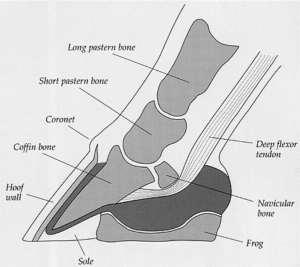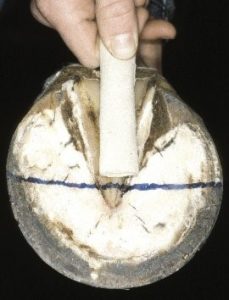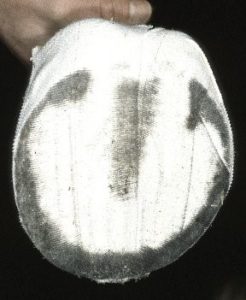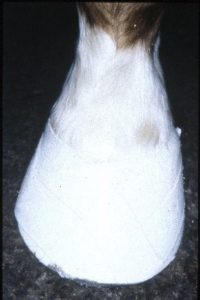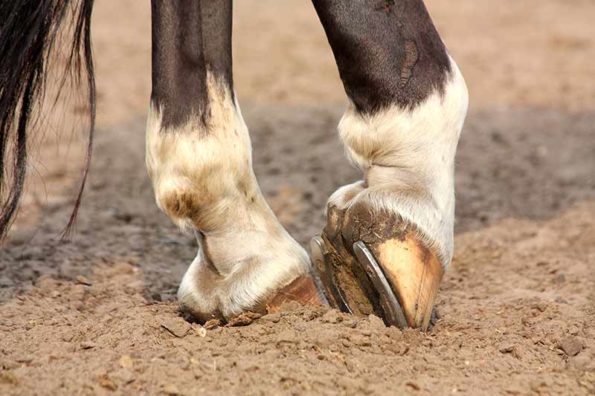
Laminitis means inflammation of the laminae of the hoof. Another term for laminitis is “founder”. The laminae are folded ridges that interlock and glue the hoof wall to the pedal bone. In laminitis, there is damage to the interlocking laminae resulting in separation of the pedal bone from the hoof wall. In severe cases this may allow the pedal bone to rotate or fall through the sole.
Horses that have had laminitis may have growth rings in the hoof wall, they may have a dished appearance to the hoof, a depression in the coronary band and often a dropped sole. Once an animal has had laminitis it will always be prone to laminitis. Laminitis is controlled, never cured.
Risk factors:
- Obesity – the most common risk factor!!!!
- Being a pony – ponies are at a higher risk of laminitis, but it still can occur even in the biggest of horses.
- Overeating of foods rich in carbohydrate or rapidly fermentable fibre ie. grains, coarse mixes, or simply new grass growth. The grass does not have to be long and lush, a small amount of new grass growth in a short paddock after a bout of rain is all it takes sometimes.
- Any illness which involves a“toxemia”. This may be a bacterial infection or following the ingestion of plant or chemical toxins.
- Cushing’s Disease. This is a condition due to an abnormality of the pituitary gland in the horse’s brain. Horses fail to shed their winter coat, the coat becomes long and curly, they may drink and urinate excessively.
- Weight-bearing laminitis. When the horse is severely lame on one leg and has to put all his weight on the other limb they often suffer from laminitis in the weightbearing limb.
- Concussive laminitis (road founder). When horses are subjected to fast or prolonged work on hard surfaces they may develop laminitis as a result of trauma to the laminae.
- Equine Metabolic Syndrome – Hormonal problems in animals which are “good doers”- similar to a type II diabetes.
Signs of laminitis:
- Classic laminitis stance – the forefeet are placed out in front and the hindlimbs are placed forward under the abdomen to take as much weight as possible off the front feet (the front feet are usually more severely affected). Looks like the horse is leaning back
- Stiff gait, especially when turning or on hard surfaces, or reluctant to move/walk
- Shifting weight from one foot to the other
- Hooves may feel warm
- Bounding digital pulses
- Sweating, trembling, panting
- Lying down more than usual
If your horse gets laminitis, call your veterinary surgeon. Laminitis is just as much an emergency as colic, and often just as painful.
Treatment
- Remove the animal from the source of the problem, if it is at grass put them in a deeply bedded stable or sand yard.
- If the stable is a long way from the field, float them home rather than making them walk
- Confine the animal to a small area (stable, stall or yard), deeply bedded with clean, dry, shavings or sand, at least 18 inches deep, covering the whole floor area, the horse can then set their feet at whatever heel height they feel most comfortable.
- Keep them quiet and encourage them to lie down.
- Your horse will need to remain confined ideally in a stable for 10-14 days after it is sound, without painkillers.
Medical care
- Pain management usually starts with twice daily phenylbutazone and then altered for the individual horses pain. Other pain medications may be needed in severe cases
- If an underlying cause is suspected (i.e. Cushings), further testing should be carried out after the laminitic episode. Conditions like cushings can then be managed medically, levering the risk of future laminitic episodes.
Foot Care
- Fit frog supports to your horse’s feet to take some of his weight through the frog, and thus relieve some of the weight taken through the wall. (see fitting frog supports)
- Keep the toes short to minimise the tension on the deep digital flexor tendon each time the foot breaks over when walking. Long toes will increase the pull on the laminae. If the feet are very painful, it may be necessary to wait for the laminitis to settle down for a few days before getting the farrier, or a Vet may be required to nerve block the feet for the farrier.
X-rays can be taken for the farrier, to assist with the length of trimming - It may be necessary to take x-rays of the pedal bones to see how far they have sunk or rotated, and to monitor progress which can also assist with Farrier trimming
Diet and management
- The vet will recommend a forage diet, using a feed with the Laminitis Trust Approval Mark. ie Hygain Ice, Speedi Beet
- In pasture based laminitis, grass hay can still aggravate laminitis. Soaking grass hay by submerging it in water for several hours (longer in winter than in summer) before feeding can reduce the amount of fructans (sugars) in the hay making it safer.
- Alternatively lucerne hay/chaff may be fed as it has different storage sugars to grass hays.
- Limiting the grass intake can be accomplished by using a grazing mask or muzzle or by restricting the area available for grazing or strip grazing.
- There are certain conditions that increase the risk of pasture laminitis. For more information see the following website: www.safergrass.org
- Ideally body condition should be maintained so there is not a fat depot along the crest or at the tail head, around the sheath or udder or over the loins. You should be able to feel the ribs easily by running your hand along their side.
- Any feed changes need to be gradual, animals should never be starved to make them lose weight, this can be dangerous causing a disease called hyperlipaemia.
- For weight loss, feed 1.5% of body-weight per day. This includes all feeds and hay (before soaking). For example, a 300kg pony needs 4.5kg of feed/hay in one day
- Once the animal has recovered from a bout of laminitis a combination of diet and exercise should be used to control body weight.
Fitting Frog Supports
A correctly fitted frog support will improve the comfort of over 80% of laminitis cases. They gain immediate relief and change their stance. Laminitis cases tend to adopt a heel loading and toe relieving stance with the limbs thrust out forwards. After fitting frog supports, the horse brings his feet back under himself and stands with his affected limbs in a more normal position.
The principle of fitting frog supports is to increase the thickness of the horse’s frog so that when he stands, some of his weight is taken through the frog, and thus relieves some of the weight taken through the wall and hence the laminae. The laminae in laminitis horses are both painful and unstable. Frog supports therefore reduce the strain on the laminae and reduce the likelihood of the pedal bone sinking/rotating.
You will need two bandages; a soft cotton bandage to place along the frog, and an elastoplast type bandage to wrap around the foot in order to keep the cotton bandage in place.
Firstly, pick out the foot and brush it clean of mud and other debris. Place the cotton bandage along the frog and look across the ground surface of the foot. The cotton bandage should be about 1- 1.5 cm higher than the walls of the foot at the quarters.
If necessary cut down the bandage roll so that when one end is placed about 1 cm behind the true point of frog, the other end finishes at the base of frog.
One person then holds up the foot and keeps the cotton bandage in the correct place along the frog while the other person wraps the foot with the elastoplast bandage to keep the frog support in place. Be sure not to bandage tightly over the coronary band and the heels. If the elastoplast does go over the coronary band it should be trimmed with scissors. In stabled horses frog supports such as these may stay in place for up to one week. Monitor and change them if the heel areas are filling up with shavings or the toe is worn through.

